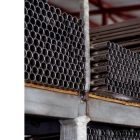Summary:
Top 3 Stainless Steel Pipe Material Types and How They Impact Performance
What Are Stainless Steel Pipes?
Austenitic Stainless Steel Pipes
Ferritic Stainless Steel Pipes
Martensitic Stainless Steel Pipes
Comparing the Performance of Different Stainless Steel Pipe Material Types
What Are Stainless Steel Pipes?

Stainless steel pipes are essential components in many industries due to their impressive strength, durability, and resistance to corrosion. Essentially, these pipes are made from stainless steel, which is a steel alloy containing at least 10.5% chromium. This chromium content is what gives stainless steel its remarkable resistance to rust and staining. Because of these properties, stainless steel pipes are widely used in applications ranging from construction and chemical processing to medical and food industries, where they need to withstand high temperatures, pressure, and harsh chemical environments.
Importance of Material Selection
Choosing the right type of stainless steel pipe is crucial for the success of any project or engineering task. Each type of stainless steel pipe has distinct physical and chemical characteristics that can significantly impact its performance and longevity. For instance, some types of stainless steel pipes are better suited for high-temperature applications, while others excel in corrosive environments. Understanding the different stainless steel pipe materials allows engineers and procurement professionals to make informed decisions, ensuring that the pipes chosen will meet the specific demands of their application and contribute to the overall safety and efficiency of the system.
Overview of Different Material Types
Stainless steel pipes come in several main types, each with its unique properties and ideal use cases. The most common types include austenitic, ferritic, and martensitic stainless steels. For example, austenitic stainless steels are favored for their excellent corrosion resistance and toughness, making them ideal for a wide range of applications. On the other hand, ferritic stainless steels are known for their good oxidation resistance and cost-effectiveness, while martensitic stainless steels offer high strength and hardness but are less resistant to corrosion. Knowing the characteristics of these different stainless steel pipe materials helps in selecting the most suitable one for your specific needs and ensuring optimal performance.
Austenitic Stainless Steel Pipes
Characteristics of Austenitic Stainless Steel
Austenitic stainless steel is the most common type of stainless steel, and it is renowned for its exceptional corrosion resistance and excellent mechanical properties. This type of stainless steel contains high levels of chromium (typically around 16-26%) and nickel (around 6-22%), which gives it a face-centered cubic (FCC) crystal structure. This structure provides austenitic stainless steel with a unique combination of properties, including high ductility, good weldability, and resistance to both oxidation and corrosion. The non-magnetic nature of austenitic stainless steel makes it particularly valuable in applications where magnetic interference could be problematic.
Common Applications and Uses
Due to its versatile properties, austenitic stainless steel pipes are used in a wide range of applications. In the chemical and petrochemical industries, they are favored for their ability to resist aggressive chemicals and high temperatures. In the food and beverage industry, their non-reactive nature ensures that they do not affect the taste or quality of products. Additionally, austenitic stainless steel pipes are commonly found in architectural applications, medical devices, and household items, where both aesthetics and functionality are crucial. Their durability and resistance to environmental factors make them an excellent choice for numerous demanding environments.
Pros and Cons of Austenitic Stainless Steel Pipes
Austenitic stainless steel pipes offer several advantages. Their superior corrosion resistance and non-magnetic properties make them suitable for many specialized applications. They also have good weldability, which is important for constructing complex piping systems. However, they do come with some drawbacks. Austenitic stainless steel tends to be more expensive than other types, such as ferritic stainless steel. Additionally, while it is highly resistant to corrosion, it is not immune to stress corrosion cracking, especially in certain chloride environments. Balancing these pros and cons is crucial when selecting the appropriate material for your project.
Ferritic Stainless Steel Pipes
Properties of Ferritic Stainless Steel
Ferritic stainless steel is known for its distinctive magnetic properties and its robust resistance to oxidation. This type of stainless steel contains a lower percentage of chromium compared to austenitic stainless steels, typically ranging from 10.5% to 27%, but it lacks significant amounts of nickel. Instead, ferritic stainless steel features a body-centered cubic (BCC) crystal structure. This structure provides ferritic stainless steel with a combination of excellent resistance to stress corrosion cracking and good formability. Although ferritic stainless steels have lower toughness compared to austenitic types, they are often chosen for their high resistance to stress corrosion and their lower cost.
Typical Applications and Advantages
Ferritic stainless steel pipes are widely used in applications where moderate corrosion resistance and good mechanical properties are required. They are commonly found in automotive exhaust systems, industrial furnaces, and heat exchangers. In the architectural field, ferritic stainless steel is used for its aesthetic appeal and durability in various exterior applications. Its excellent resistance to oxidation at high temperatures makes it suitable for parts exposed to elevated heat conditions. Additionally, ferritic stainless steel pipes are often used in household appliances and kitchen equipment due to their resistance to corrosion from common acids and cleaning agents.
Limitations of Ferritic Stainless Steel Pipes
While ferritic stainless steel pipes offer several benefits, they are not without limitations. One of the primary drawbacks is their relatively low toughness compared to austenitic stainless steels, which can make them less suitable for applications involving high-impact or low-temperature conditions. Additionally, ferritic stainless steel has lower resistance to pitting and crevice corrosion compared to other types of stainless steel, particularly in chloride environments. Its magnetic properties, while advantageous in some applications, can be a disadvantage in environments where magnetic interference needs to be minimized. Despite these limitations, ferritic stainless steel remains a cost-effective and practical choice for many applications.
Martensitic Stainless Steel Pipes
Martensitic Stainless Steel: An Overview
Martensitic stainless steel is known for its high hardness and strength, which is achieved through a specific heat treatment process. This type of stainless steel typically contains a high amount of chromium (around 12-18%) and varying amounts of carbon, which contribute to its martensitic microstructure. The martensitic phase is a result of the transformation of austenite during cooling, leading to a hard and brittle structure that is distinct from the more ductile austenitic and ferritic types. Martensitic stainless steel can be heat-treated to achieve different levels of hardness and strength, making it a versatile material for applications requiring a tough and wear-resistant surface.
Applications in Various Industries
Martensitic stainless steel pipes are used in applications where high strength, hardness, and resistance to wear are essential. They are commonly found in the manufacturing of tools, blades, and high-performance components in the aerospace and automotive industries. For example, martensitic stainless steel pipes might be used in high-pressure hydraulic systems or in situations where mechanical stress and wear are significant concerns. In addition, their ability to maintain hardness at elevated temperatures makes them suitable for certain high-temperature applications. Despite being less resistant to corrosion compared to austenitic and ferritic stainless steels, martensitic stainless steel is chosen for its superior mechanical properties and toughness.
Benefits and Drawbacks of Martensitic Stainless Steel Pipes
Martensitic stainless steel pipes offer several notable benefits. Their high hardness and strength make them ideal for applications that involve heavy wear or high mechanical stress. They also exhibit good machinability, which is advantageous in manufacturing complex components. However, these pipes come with some drawbacks. One of the main limitations is their relatively poor corrosion resistance compared to austenitic and ferritic stainless steels, which can restrict their use in highly corrosive environments. Additionally, martensitic stainless steels are prone to brittleness at low temperatures, which can affect their performance in colder conditions. Balancing these strengths and weaknesses is important when selecting martensitic stainless steel pipes for specific applications.
Comparing the Performance of Different Stainless Steel Pipe Material Types
Performance Metrics: Strength, Durability, and Corrosion Resistance
When comparing different types of stainless steel pipes, it’s crucial to evaluate their performance across several key metrics: strength, durability, and corrosion resistance.
Strength:
Austenitic Stainless Steel: Known for its excellent toughness and strength, particularly when alloyed with high nickel content. It can withstand significant mechanical stress and is less likely to become brittle under extreme conditions.
Ferritic Stainless Steel: Generally has good strength but is not as strong as austenitic stainless steel. It is better suited for applications where moderate strength is sufficient.
Martensitic Stainless Steel: Offers the highest strength and hardness among the three types due to its heat-treated martensitic structure. This makes it ideal for applications requiring high mechanical strength.
Durability:
Austenitic Stainless Steel: Provides superior durability due to its resistance to stress corrosion cracking and its ability to maintain toughness over a wide range of temperatures.
Ferritic Stainless Steel: While durable, it may not perform as well in high-stress environments compared to austenitic types. It is, however, resistant to oxidation at high temperatures, which enhances its durability in such conditions.
Martensitic Stainless Steel: Highly durable in terms of hardness and wear resistance but may be less durable in corrosive environments. Its brittleness at low temperatures can also impact its overall durability.
Corrosion Resistance:
Austenitic Stainless Steel: Exhibits the best corrosion resistance among stainless steel types, making it suitable for harsh environments and applications exposed to corrosive substances.
Ferritic Stainless Steel: Offers good resistance to oxidation and corrosion but is less resistant to chloride-induced pitting compared to austenitic stainless steels.
Martensitic Stainless Steel: Generally has lower corrosion resistance compared to austenitic and ferritic types. It is more prone to rust and corrosion, particularly in chloride-rich environments.
Cost Analysis and Longevity of Each Material Type
Cost and longevity are critical factors to consider when selecting stainless steel pipes:
Austenitic Stainless Steel: Typically the most expensive option due to its complex alloy composition and superior performance. However, its longevity and resistance to corrosion often justify the higher cost, especially in high-demand applications.
Ferritic Stainless Steel: Generally more affordable than austenitic stainless steel. Its cost-effectiveness makes it a popular choice for applications where high corrosion resistance is not as critical. Its longevity is good, particularly in moderate environments.
Martensitic Stainless Steel: Often priced lower than austenitic stainless steel but higher than ferritic types. Its longevity depends on the specific application; while it offers excellent wear resistance, its susceptibility to corrosion can affect its overall lifespan in certain environments.
Choosing the Right Stainless Steel Pipe Material for Your Needs
Selecting the appropriate stainless steel pipe material involves balancing performance metrics with cost and application requirements. For high-corrosion environments or where mechanical stress is a primary concern, austenitic stainless steel might be the best choice. Ferritic stainless steel is ideal for moderate conditions where cost is a factor, while martensitic stainless steel excels in applications demanding high strength and hardness but may need additional protective measures in corrosive settings.
Understanding these comparisons will help you make an informed decision about which stainless steel pipe material types best fits your specific needs, ensuring optimal performance and value for your project.




